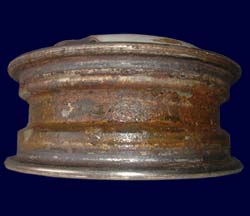Rust and Corrosion
 Where Does the Moisture Come From?Rust and corrosion form when there is moisture present in the air within a tire/wheel. As the vehicle is driven, the tire gets hot and the moisture will vaporize. Some will migrate through the pores of the tire, while the majority will condense onto the wheel possibly forming rust and corrosion. This repeated vaporizing and condensation action will eventually concentrate on the wheel. Most people do not realize that moisture migrating through the tire will cause the steel belts to rust. It is very important to drain water from all air sources (compressors and lines) as a daily routine procedure. These are the main sources of moisture in a tire. If possible, an air dryer should be attached to all air hoses. Make sure the tire is dry and free of debris prior to mounting. Mounting solutions are a major source of moisture and often contain incompatible substances. Whenever possible choose pre-mixed mounting solutions. This helps avoid issues arising from poor quality water and improper mixing. Some water based products do not contain rust inhibitors. Insist on one that contains rust and corrosion inhibitors. One of the most important attributes of Ultraseal Tire Life Extender/Sealer is that it contains a highly effective and proven rust inhibiting formula to protect all types of alloys and steel found in wheels and steel belts. Ultraseal has the ability to prevent the formation of rust and will inhibit any existing rust and corrosion. Ultraseal protection begins on the inside and protects throughout. Additionally, Ultraseal prevents outside contaminants from entering a tire through a puncture site due to the sucking effect caused by tire flexing. Note: Even a small amount of water in a tire can dilute and reduce the effectiveness of Ultraseal. |





